Steranko history of comics book 1
| série: | Etude Comics |
| dessinateur / scénariste: | Steranko James |
| éditeur: | Supergraphics EO 1970 |
| genre: | Etude |
| classement: | biblio1 |
| date: | 1970 |
| format: | broché, grand format |
| état: | TBE |
| valeur: | 30 € |
| critère: | ** |
| remarques: | the Steranko History of Comics, volume 1, 84 pages, N&B Introduction by Federico Fellini Preview by James Steranko - radio was in the thirties, the center-stage in America - Homer with his myths and heroes, was one of the precursor of comics - American folklore heroes like Paul Bunyan (the giant who created the Grand Canyon), John Henry (the champion of rail-road men) and Joe Magarac (who fashioned rails by squeezing hot metal through his fingers) were in fact the first comic heroes - comics inspired also the film industry - "Punch and Judy" in the 1600's was the first comic book - Ben Franklin introduced in the 1700's the word ballons in his Gazette - Adventure strips (like Tarzan) were born out of the depression - the first comic books resulted of the Pulp Stories (= cheap popular periodicals) - Buck Rogers by Philip Nowland, drawing: Dick Calkins, with his mate Wilma Deering, the doctor Huer and the villains: Killer Kane, Ardala and the space-pirat Black Barney, they were old-fashioned mechanical but somehow charming comics - Dick Tracy = most famous police strip inspired by the Chicago gang war - Alley Oop = humorous comics - Brick Bradford = science fiction-fantastic comics - Flash Gordon was the ultimate statement of high fantasy in the comics, Alex Raymond developed the technique of "feathering" series of fine lines to soften an edge or create a contour, Flash Gordon was the pendant of John Carter, - Rip Kirby was a new police style: the intellectual crime strip - Terry and the Pirates, Milton Caniff created a new strip with a sex appel style in the character of Dragon Lady, Caniff was the Hemingway of comics further comic creations: - Wash Tubbs and captain Easy + Buz Sawyer by Roy Crane - bringing up father (Maggie and Jiggs) by Geo Mac Manus - the Gumps by Sidney Smith - Barney Google and Snuffy Smith by Billy DeBeck - Happy Hooligan + Alphonse and Gaston by Frederick Burr Opper - Mutt and Jeff by Bud Fisher - Tillie the Toiler by Russ Westover - Tailspin Tommy by Hal Forrest - Smilin' Jack by Zack Mosley - Barney Baxter by Frank Miller - Red Barry by Will Gould - King of the Royal Mounted by Allen Dean - the Lone Ranger by Charles Flanders - Claire Voyant by Jack Sparling - Bruce Gentry by Ray Bailey - Radio Patrol by Charles Schmidt - Ace Drummond by Clayton Knight - American Western Comics did never produce a long-lasting commercial success, possibly because films filled the public need - the Phantom (the Ghost who walks) brought 1936 the first masked costume hero - the history of the comic book, created in 1929 by George Delacorte with "the Funnies" - publication of Detective Comics in 1937 1) the Pulp Magazines - beginning of the pulp stories (= untrimmed magazines named for the soft paper flecked wth shreds of wood fibre on which they were printed because there was nothing cheaper available), they were aimed at the masses and they were fo full comic magazines but story novels, an illustration appeared only on the covers and sometimes sporadically in the magazines - the first most famous pulp was issued under the title of "the shadow", the series lasted from 1931 to 1949 with the subject of crime fiction, the shadow character was created by Walter Brown Gibson who wrote hereof 282 stories - the masked avenger cult was continued with "Fantomas" in France, in the USA came "the Gray Seal" and particularly "Doc Savage", (= the man in bronze) written by Lester Dent in 1933, Doc Savage was the superman of the 30's, Dent composed 165 Doc Savage stories with a same basic formula 2) Crime Fiction Series - the Phantom Detective (1933-1953) followed Doc Savage with 170 stories written by Wayman Jones but it lacked the sensationalism of the shadow or the imaginative variety of Doc Savage - the Spider was an amalgam of the three previous characters and was the ultimate right-winger of the pulps (1933-1943), it was created by Thomas Maitland Scott - Operator No. 5, secret service, precursor of James Bond, recounted the invasion of America by the Purple Emperor, 48 stories written by Frederick Davis in 1936 (with superb covers) - the Black Bat = nocturnal nemesis of evil and ancestor of Batman, appears in 1939 fighting in the character of a blind man against the crime (written by Murray Leinster) - the Avenger by Paul Ernst in 1936, created to compete against Doc Savage, the Avenger was known under the name of "the Plastic Man" or the Man with 1000 faces further titles in the crime fiction series: - captain Satan, written by William O'Sullivan in 1938 - captain Zero by Kirk Allyn (1949) - the Angel by Edward S. Ronns (1941) - the Whisperer by Cliff Goodrich, this title became the lead feature in crime busters - Secret Agent X (the master spy) by Paul Chadwick - captain Hazzard by Chester Hawks - Jim Anthony by John Grange - the Night Hawk, enemy of crime in the style of Batman other characters included: - Don Diavolo - the Scarlet Wizard - the Green Lama - the Ghost - - the Black Hood - the Cobra - Moon Man - Secret Six (the Ace King) - - Suicide Squad (with Ace-G-Man, the FBI Agent) - Public Enemy - - Domino Lady (the blonde Phantom) 3) the Villain series - Dr. Satan, by Paul Ernst in Weird Tales (1935), dr Satan used the power of black magic and was certainly the best character of the villain series other titles included: - doctor Death - Octopus, the Scorpion - doctor Yen Sin - - the Mysterious Wu-Fang - 4) Air Series - G-8 and his battle aces (the airborne master spy), was the most popular title written by Robert Hogan in 1933, Hogan was known as the nation's most prolific pulp writers - Dusty Ayres and his battle birds (ancestor of Buck Rogers) - Bill Barnes, the air adventurer was the closest rival of G-8 other titles included: - Philip Strange in "Flying Aces" - Terence X O'Leary's War Birds - the Griffon - Tailspin Tommy - Captain Yank - Battle Birds - - Phineas Pinkham, Daredevil Aces - Sky Fighters and the long Eagle were further romanticised tales of the 1914-1918 aerial conflict 5) Adventure Series - started in 1912 with "Tarzan of the Apes" by Edgar Rice Burroughs in All Story Magazine and Amazing Stories, the Tarzan series were followed by - Tanar of Pellucidar - John Carter of Mars - Carson Napier of Venus - - Nu, the prehistoric hunter (in the book the Eternal Lover) - Burroughs was a great pioneer of adventure-fiction, he died in bed 1950 but many other series have been inspired by his hero: - Ki-Gor or Kaanga in Jungle Stories - Ka-Zar, the man of the jungle - Matalaa, the white savage - Robert Howard was the most exceptional follower of Burroughs, he created the sword and sorcery genre with: - Bran Mak Morn, the Pict warrior king - Solomon Kane, the Puritan adventurer - King Kull (version of the Atlantis king) - Conan the Cimmerian (the Barbarian saga) - Howard's first stories appeared in Weird Tales, however Howard committed suicide in 1936 at the age of 30 - Howard Phillips Lovecraft did also excel in the realm of supernatural horror stories with 2 main subjects: - the Cthulhu Mythos (evil gods) - the Kadath series (a bizarre dream world) in 1935 two horror magazines were published: - Horror Stories" and "Terror Tales", they were known as he "bloody" pulps! further series including the famous "Detective Stories" developed also such as: - Black Book Detective - Black Mask - Sherlock Holmes - - Nick Carter - Sam Spade (the Maltese Falcon) - - Perry Mason (the American Sherlock Holmes) - - the Pulp Stories had also their western series, such as Buffalo Bill, Wyatt Earp and Jesse James but the film industry monopolized most of the readers' interest 6) Science Fiction series - the most popular author was "Doc Smith" with his Skylark Saga, Jack Williamson created the Legion of Space further science fiction series included such titles as: - captain Future (by Edmond Hamilton) - Amazing Stories - - Argosy - Astounding Stories - Fantastic Adventures - - Future Fiction - Galaxy - Out of this World - Planet Stories - - Super Science - Thrill Book - Weird Tales - and with the technical progress, the Comic Book toke over the part of the Pulp Stories 7) Superman (the super Star) - created 1933 by Jerry Siegel during a sleepless night with Jos Shuster as the designer, both were 17 years old - Superman was somehow inspired by Doc Savage , the Superman charisma consisted of three elements: - the visitor from another planet (Krypton) - the superman being (inspired also from the ant?) - the dual identity (Superman being Clark Kent) - document page 35: first page of Superman (1939), neither the Bell Syndicate nor the United Features were interested in publishing Superman, it was only after six years of its creation that Action Comics (Liebowitz and Donenfeld) agreed to publish Superman's first strips, nevertheless to say, it was a great success! - Superman represented the ultimate childhood dream-self, however Superman was coupled with a dual human personality, that of Clark Kent with his human weakness - look up in the sky! it's a bird, it's a plane, it's Superman (as spoken in the radio during 1940) - best covers in Superman magazines Nos. 11 and 23 8) Batman (the playboy hero) - first appearance in Detective Comics May 1939 no 27 by Bob Kane and Bill Finger - while Superman wanted to help those in need, Batman's task was to fight on all criminals, Superman's motivation was altmistic and benevolent n.b. altmistic = altruistic = showing a disinterested and selfless concern for the well-being of others; unselfish that of Batman was misanthropic vengeance, Batman (like Dracula) behaved in a atmosphere of superstition and supernatural, Gotham City was just another name for New York and Batman had his own car: the Batmobile - Gardner Fox was the second writer of Batman, after him came Jerry Robinson - in May 1940, Batman got a companion: Robin the Boy Wonder who was inspired from Robin Hood in an effort to humanize Batman his main adversaries (a highly exclusive criminal club) were: - the Diabolic Monk - Prof. Hugo Strange - the Joker - - Catwoman (first lady of crime) - Two Face (he adopted the number 2 as his personal symbol of crime) - Clayface - the Pinguin - - the Scarecrow - the Crime Doctor - the Cavalier - the Riddler - Batman was one of the better written comic books of the decade, best covers were shown in Detective Comics no 33 and in Batman no 3, 9 and 17 9) Captain America (the Super Patriot) - created by Jack Kirby and his partner Joe Simon, captain America emerged from the 2nd World War history in April 1941 in his own magazine with he first cover showing Hitler smashed by Captain America expressing therefore the flag-waiving spirit of American nationalism - captain America had also a companion: young Bucky Barnes who was to be replaced by Golden Girl in 1948, his main opponent was "the Red Skull" - above all, captain America represented the ideological duel between good and evil, captain America gave birth to the americanization of further comics such as: American Avenger, American Crusader, commando Yank as well as girl strips such as Liberty Belle and Yankee Girl - author Jack Kirby excelled in representing dynamic drawing showing jolting violent speed, he named his work the magnum opus - captain America was the most popular comic book of that time, he contributed to encourage he American war efforts, 1949 however captain America ceased to be a hero, sales dropped and he becane then an artifact of an era past - best covers; captain America's magazines Nos 2,5, 37 and 38 10) he Human Torch - Human Torch was he most elemental and most sensational comic character ever created in 1939 by Carl Burgos and Bill Everett, together with Frank Torpey, they started to publish Human Torch's stories in magazines called the Marvel Comics - the Human Torch represented the aspect of fury and passion in the comics - a further hero of Marvel Comics created by Bill Everett was the underwater monarch, Prince Namor = the Submariner, he was the first anti-hero character in the comics starting 1941 and remaining longer that almost every other golden age hero - a similar character made of water was the Hydroman further popular characters published by Marvel Comics: - the Angel (with a moustache) created by Paul Gustavson - Ka-Zar, the jungle lord, created by Thompson - the Thunderer (kind of Superman) - the Blue Diamond (a supernatural man) - the Challenger (the master of 1000 weapons) - the Falcon (counterpart of Batman) - the Whizzer (counterpart of Flash) - Mr. Liberty (a special figure) - Jack Frost (the king of the cold) - Monako (another version of Mandrake) - Marvel Boy (late version of Superman) - the Destroyer (another version of the Phantom) - captain Wonder (another version of captain America) - Electo (the wonder Robot) - miss America (the super girl) - the Blonde Phantom (a bespectacled detective girl) (bespectacled = wearing glasses) 11) best supporting Characters (further Super Heroes) start of a new era for Adventure Comics by Gardner Fox with - the Sandman (1938), an outlaw who put his victims to sleep - the Hawkman (1940), the birdman of Egyptian origin - the Flash (1940), fastest man in the character of the winged god Mercury - dr. Fate (the man walking through the walls) - Starman by Jack Burnley, mystery man of night but somehow imitation of Superman - the Green Lantern (1940), by Bill Finger, writer and Martin Nodell, artist = the man with the light power, became a hit in comics, his opponent Harlequin (a lady) became also very popular - Wonder Woman (1941) by William Moulton Marston, forerunner of the women's liberation movement, inspired by Aphrodite, goddess of love and her amazones, one of them Diana (Wonder Woman) is sent to the earth to help America, artist: Harry Peter - the Spectre, the man with limitless supernatural power (the Earthbound Ghost) further supporting characters were: - Aquaman - Green Arrow - Speedy - Dan the Dyna-Mite - - Tarantula (forerunner of Spiderman) - Manhunter - - Robotman and his robot-dog Robbie - - the Vigilante (the crimebusting cowboy) - - Sheena, queen of the jungle by Mort Morton (1938) - Johnny Quick, king of speed drawn so that to express extreme motion - then some artists wrote another page in the history of comics by grouping the most popular heroes under a single title: - the Justice Society of America (JSA) consisting mainly of Flash, Green Lantern, Hawkman, Sandman and the Spectre but sometimes including Superman, Batman and Wonder Woman, with the slogan: united we stand, divided we fall, each hero was usually drawn by its regular own artist, a further strip of that kind was - the seven soldiers of Victory 12) Kid Players (kid gang strips) -mostly created by Jack Kirby, starting in 1941 with "Young Allies", these kid heroes were really spin-offs of the super heroes and played against the background ofthe 2nd world war, further titles were: - the Guardian (Jim Harper) - the Newsboy Legion - the Boy Commandos (the most popular strip that l asted from 1941 to 1949) - the Victory Boys - the Little Wise Guys (protected by Daredevil, a kind of super-type mother hen) - the Boy Explorers - these kid strips were not spectacular, even naïve, but contained a kind of social conscience that attracted the readers >> quite interesting book, exhaustive and comprehensive, especially the beginning and the separate chapters in respect of Superman, Batman and Captain America - it brings also some further details about the origin and development of the US comics and is a really best average documentary book >> best covers and strips: pages 4 (Prince Valiant), 18 (the shadow), 22 (the black bat), 31 (planet stories science-aventure), 33 (wonder stories, captain future), 46/47 (bat man) enclosures 1/ front cover (from right to left and down): - Batman - Starman - Hawkman - captain America - the Human Torch -the Destroyer (?) - Sandman - Green Lantern - - Robotman - Spiderman - - Hulk, Cat Woman, the Joker and Sheena 2/ back cover (from right to left and down): - the Thunderer - captain Wonder - - the Guardian - Submariner - - Superman - the Silver Surfer - - Nick Fury - Wonder Woman - captain Nazi (?) - two pages of the book - portrait of the Spirit - Holy Moley, unpublished version of Mary Marvel cover by Jack Binder - an example of the Spirit's logo |
| couvertures: | 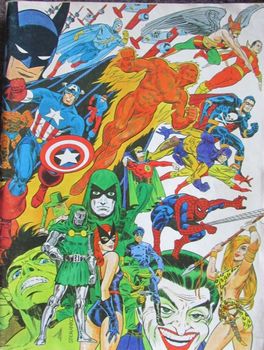 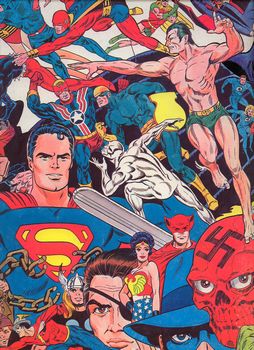 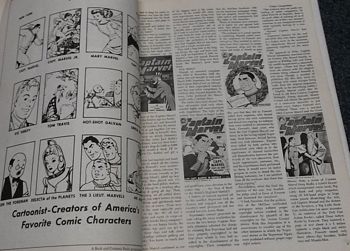 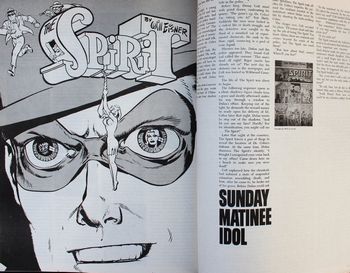 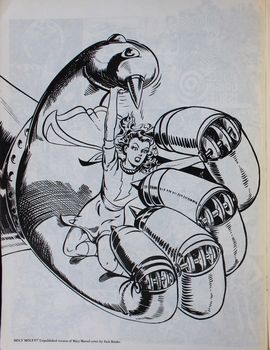 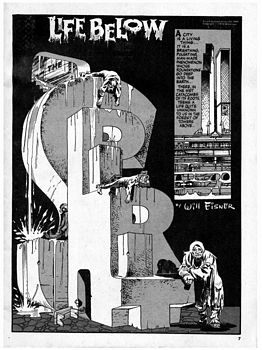 |
Copyright 2008 - 2025 G. Rudolf
